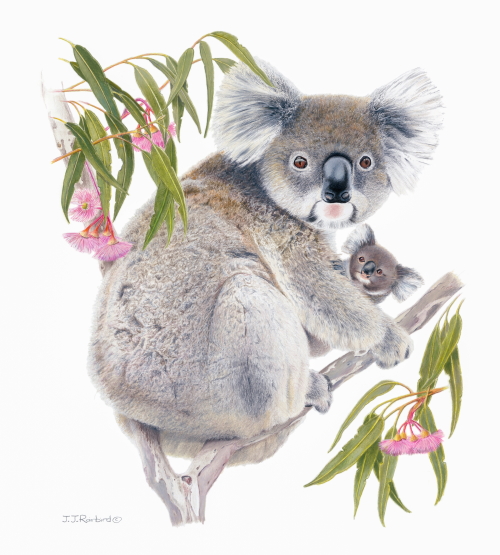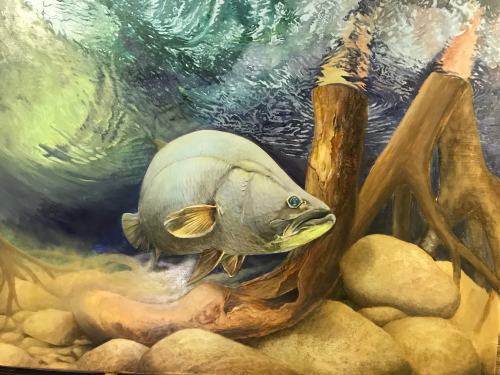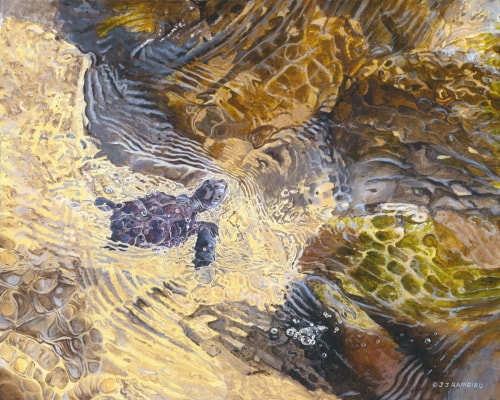Inspired by the critical need for conservation, John Rainbird creates art that connects us with the natural world. Learn more by visiting his website.
“African Elephant Bull (Moremi Bull)” pencil, 100cm x 70cm
Working as a nature artist and an environmental scientist, I got lucky being born with the surname Rainbird. Nature is, of course, the ultimate artist. It is able to throw together the most unlikely forms, colours, and textures, and the outcomes always look amazing.
“Who’s the Boss (African Buffalo)” pencil, 100cm x 70cm
I grew up in South Africa, immersed in the electric energy that is so Africa. It is the birthplace of humanity and the last great refuge for the world’s great megafauna.
“Future King” pencil, 40cm x 50cm
After completing my master’s degree in conservation biology in Cape Town, I did some traveling and ended up settling in Australia. I now live in Cairns, a small tropical coastal city that sits between the Wet Tropics World Heritage Rainforest and the World Heritage Great Barrier Reef Marine Park.

“Mother and Child (Koala)” coloured pencil, 40cm x 50cm
My art aims simply to capture the beauty of the natural world and the essence of my subjects. I have been doing a lot of work in pencil lately. This is mostly for the convenience, but also because it’s a wonderful medium in its own right.

“Barramundi” oil, work in progress, 90cm x 70cm
I love to work in oils as well, and am currently working on an oil painting of a barramundi, an iconic fish in these parts.
“Musky Rat-Kangaroos” oil, 65cm x 50cm
I have no formal art training. The various books on wildlife art featuring the great masters of this fantastic genre have been a trusty guide and a constant source of inspiration.

“Let the Adventure Begin (Green Turtle)” acrylic, 45cm x 35cm
As species and ecosystems around the world face ever greater threats from our blundering and insensitive ways, it is ever more critical to build a connection between people and the natural world. Wildlife art can play a useful role in making this connection.
“Surfing the Reef” coloured pencil, 60cm x 50cm
I am a member of Artists for Conservation, a group of five-hundred wildlife artists from around the world. Our art helps to raise funds for conservation projects.
“African Hunting Dogs” pencil, 100cm x 70cm
Wildlife art also demands a good knowledge of the subjects of anatomy, ecology and behavioral science. Our audiences are often extremely well informed naturalists. Thus, any minor errors in form, behavior or habitat are quickly pointed out. For example, cockatoos always hold their food with their left foot, so beware the artist who paints a right-footed cockatoo!
Artist John Rainbird working on “Splash of the Titan”
It is this combination of knowing the subject matter, together with the challenges of creating a distinctive work of art that I really enjoy.
Artist John Rainbird invites you to follow him on Facebook and the organization Artists for Conservation.


I was totally blown away by the detail and great composition of these wildlife drawings and paintings. I am a wildlife artist and love your artwork.
Very nice
Your drawings are an inspiration and so real . The detail is extraordinary
we love your artwork
Hi John love the Color pencil portrait of a swimming sea turtle by John Rainbird “Surfing the Reef
Keep up the GREAT work
john in Las Vegas